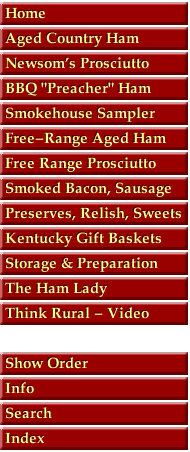
   By Matt Lee and Ted Lee By Matt Lee and Ted LeeA country ham is a wonderful thing: the hind leg of a pic, cured in salt, brown sugar, and seasonings, often ( but not always) smoked, then left to age in a dry environment for months. During that time, the meat loses up to a quarter of its weight from evaporated moisture, resulting in a transcendently delicious, rosy ham that's super-concentrated, buttery, slightly gamey, and very salty. It has more in common with Italian prosciutto than with city ham, the pink supermarket staple familiar to most Americans. City ham is cured in brine -- a totally different process, resulting in a totally different product. A seasonal southern tradition . . . Country ham is the original American ham, dating back to the days of the Virginia colonies. Ham curing was undertaken to preserve pork over long periods. Pigs were slaughtered in the winter when the cold would help preserve the meat as it cured. The hams were then hung to age throughout the summer months -- warm weather is thought to deepen their flavor. (It also causes mold growth, but the mold is totally harmless.) Most country ham is still seasonal. Every year in October and November, a fresh crop of hams comes on the market. Later in the year, longer-aged hams start becoming available, but generally the smaller ones, a diminutive 12 pounds or so, are snatched up early. By the following September, it can be hard to find a whole ham smaller than 18 pounds. Modern ham producers can control for temperature to avoid that cycle, but many of our favorites still do things the old-fashioned way and keep roughly to this schedule. It's traditions like that as well as other regional nuances that differentiate the many country hams When you eat a country ham, you're tasting the variety of the pig, the feed it was raised on (for example, Smithfield hams from Smithfield, Virginia, historically were raised exclusively on peanuts, and often still are), and the particulars of the curing process: the ingredients in the cure, the duration of smoking (if any), the atmospheric conditions, and the length of aging. Discussions of the ham "terroir" -- similar to those that accompany the appreciation of fine wines, chocolate, and coffee -- are not uncommon among aficionados. Cooking is optional. . . In the South, the traditional preparation of a whole country ham for the dinner table is a days-long production. It requires scrubbing the innocuous mold off, sooting the ham in cold water for a day or two, simmering on the stovetop for several hours, and finally baking it with a glaze. Such a ham is thinly carved and paired on the plate with a piquant relish or chutney to offset the salt for holiday meals, or tucked into buttermilk biscuits for festive cocktail hours. In recent years, however, we've started to look to European ways with dry-cured hams; we're just as likely to eat it uncooked and sliced paper-thin, appreciating its intense saltiness, minerality, and creamy fat. And we've seen chefs serve a tasting plate of different country hams so diners can compare and savor their various flavors. Along with this more broad-based appreciation have come creative uses in the kitchen. We love to use country ham in place of bacon or pancetta in egg or pasta dishes (like linguine). We also like playing around with preparations that honor the ham's down-home roots -- a boldly flavorful ham relish for spreading on crackers or sandwiches or a cheesy spoonbread made with grits. Whether it's being served as an artisanal treat or a country tradition, we're just glad to see this once-humble ham high on the hog. Newsom's Country Ham is one of four country hams that the Lee Brothers say that they like and would recommend for Fine Cooking readers to try. Newsom's Country Ham: These hickory-smoked Kentucky hams boast an all-natural, nitrite- and nitrate-free cure of salt and brown sugar. Aging for around a year creates a mellow ham with a distinctly ruby color that lends itself well to baking. Fine Cooking April/May 2013 |